Scotland claims to have invented the modern world. In his book, How the Scots Invented the Modern World, Arthur Herman attributes this to Presbyterianism, the Scottish Enlightenment, the steam engine, and civil engineering—a compelling argument. But if it comes down to the sheer weight of actual invention then the country that gave us Levi jeans, paperclips, the electric light bulb, chewing gum, golf balls, typewriters, Coca-Cola, personal computers, the internet and Barbie must surely win the prize. However, if measuring innovation by longevity, Greece takes the spotlight with democracy, theatre, medicine, and the Olympic Games. And of course we all know what the Romans ever did for us.
Our argument is straightforward: the modern world was invented in the square mile of London between Piccadilly Circus and Oxford Street. Here, public healthcare, consumerism, and popular culture evolved into the three elements that most directly impact our lives in the twenty-first century.
Think of it as Spex and Rugs and Rock and Roll:
Spex: The invention of spectacles, foundations of the NHS and other innovations in medicine and public health.
Rugs: A variety of floor coverings and related products that Liberty imported, along with Wedgwood’s earlier Soho based innovations, transformed shopping into a cultural activity.
Rock and Roll: The Beatles, Bowie, punk, Lovers’ Rock, folk rock and the musical - Soho creations that form the soundtracks of our lives.
Our case is set out below, helped along by some appropriate song titles.
I Can See For Miles
The area now known as Soho was seized by Henry VIII during the Reformation and incorporated into his hunting grounds. The hunting cry of 'So-Ho,' much like 'Tally-Ho,' gave rise to its name. Fields gave way to houses from the mid-seventeenth century, with Soho Square, Greek Street, Frith Street, and Gerrard Street all being developed. We can view Soho as a district of two halves. Wardour Street runs north to south as a central axis. Everything to the east started out according to a plan—a grid system with the main streets running south from Soho Square. Considerable building and rebuilding took place in the eighteenth century, with elegant Georgian terraces lining the streets. Development to the west of Wardour Street took place a little later and was constrained by the original estate boundaries upon which it was developed. As a result, housing there was more compact and streets narrower. While the east side was grander, the west and south proved popular for incomers, especially French Huguenot refugees.
In 1720, at the dawn of the Georgian age, London's Soho was a dynamic and eclectic neighbourhood characterized by its cosmopolitan atmosphere and cultural vibrancy. It had become a refuge for many immigrants, especially French Huguenots fleeing religious persecution, who brought with them skills in textiles and craftsmanship. This influx of diverse communities, including Italians and Jews, was reflected in the area's daily life.
Soho's streets were bustling with activity, from markets and shops to coffee houses and taverns. These venues were not only commercial hubs but also centres of social and intellectual exchange. Coffee houses, in particular, played a crucial role in spreading new ideas, serving as informal forums for debate and discussion on politics, philosophy, the arts, and sciences.
This cultural melting pot led to a shift in fashion, with street styles eclipsing those of the court. New trends spread via fashionable displays at coffee houses, pleasure gardens, and theatres. Britain’s imperial presence in the world began to influence fashion styles, and Soho’s tailors and artisans adeptly catered to the demands of a fashion-conscious clientele.
The spirit of Soho in 1720 was one of openness and experimentation. The district was a breeding ground for new ideas, attracting a bohemian crowd who contributed to its vibrant cultural life. The mix of different cultures went hand-in-hand with the acceptance of new and sometimes radical ideas, transforming the face of Georgian London.
Today, 90 Shaftesbury Avenue stands at the corner with Macclesfield Street, on the northern boundary of what is now London’s Chinatown. The building replaces what was formerly 9 Macclesfield Street, demolished around 1886 for the construction of Shaftesbury Avenue. It had been a handsome shop, built in the Palladian style during the 1720s for its leaseholder, optician Edward Scarlett. Around 1725, Scarlett invented the modern spectacle frame by adding hinged struts that hung over the ears. Before this innovation, spectacles perched precariously on the nose or were hand-held. Scarlett’s invention allowed people to walk and see simultaneously. He further improved spectacles by grinding lenses to individual specifications. His success led to his appointment as optician by Royal Appointment to King George II by 1730. Spectacles had become fashionable wearables.
Spectacles were to loom large in Soho’s legend. By the 1960s, the wearing of glasses had become less than fashionable. This dramatically changed when John Lennon was first seen in public in his 'NHS glasses'—one Sunday morning on a Soho street.
The First Cut is the Deepest
Georgian Soho continued to drive cultural change. In our story "Walking With Ghosts," we describe how enterprising Italian socialite Teresa Cornelys transformed Soho's Carlisle House into a hub of extravagant masquerade balls. Attracting the elite with its opulence and spectacle, it represented the world’s first nightclub. Charles Ignatius Sancho, a former slave turned influential abolitionist, music composer, and the first black man to vote in Britain, likely frequented these events. Soho's history is rich with tales of resilience and creativity, encapsulated by figures like Cornelys and Sancho, who left lasting impacts on London's cultural landscape.
It wasn’t all about fashion and culture. While Teresa Cornelys brought her unique flamboyant hedonism to London, pioneering Glaswegian anatomist William Hunter established his private anatomy school in 1764 on Great Windmill Street. Hunter revolutionized the study of anatomy and transformed medical education with a school that boasted a unique theatre and a museum holding thousands of specimens. William’s brother John Hunter joined him in Soho, living in Golden Square, and became equally, if not more, famous than William. A brilliant dissector and scientist, John Hunter is widely regarded as the founder of modern surgery.
China Girl
Hunter’s Anatomy School became a showroom for the new sciences of medicine and surgery. Meanwhile, just a ten-minute walk away on Greek Street, a showroom was opening to celebrate the new age of industry. Josiah Wedgwood’s showroom was one of the first purpose-built retail showrooms, setting a new standard for marketing and sales in the 18th century. It was not only a space for displaying products but also a venue for demonstrating the artistic and technological advancements of Wedgwood's pottery. Wedgwood, one of the greatest innovators of all time, revolutionized industry by pioneering mass production techniques and marketing strategies, including celebrity endorsements and money-back guarantees to build brand loyalty and prestige. It was at his Greek Street showroom that Wedgwood introduced the concept of BOGOF—Buy One, Get One Free. His emphasis on scientific experimentation set new industry standards, while his marketing acumen laid the foundation for modern consumer culture.
In contrast to many capitalists, both then and now, Josiah Wedgwood demonstrated the principles of social responsibility in industry. While Britain at that time was economically benefiting from the slave trade, Wedgwood was a vocal opponent of slavery, creating the famous anti-slavery medallion with the slogan "Am I Not a Man and a Brother?" Perhaps today such actions would be dismissed by some as ‘woke,’ but in Georgian Britain, Josiah Wedgwood showed that social responsibility was integral to entrepreneurship. It still is.
Revolution
By the nineteenth century, Soho's character had changed considerably. In "The Forsyte Saga," Galsworthy described it as “untidy, full of Greeks, Ishmaelites, cats, Italians, tomatoes, restaurants, organs, colored stuffs, queer names, people looking out of upper windows; it dwells remote from the British Body Politic.” Impoverished, disease-ridden, and seen as a dangerous place that harbored criminals and radicals—this was the Soho that Karl Marx lived in, that Dickens wrote about, and where cholera claimed over 600 lives. Yet, behind this perception was a neighborhood open, tolerant, and welcoming to outsiders.
As we describe in our story Marx and music in Soho, the Marx family moved into a flat on Dean Street, joining the 13,000 foreigners who moved to London in the 1840s, many of them political refugees. In the upstairs room of Soho’s Red Lion pub, Karl Marx introduced the world to Communism, an idea that would define government for over half of the world’s population in the following century.
There’s no evidence that Karl Marx ever met Dr. Joseph Rogers, but they almost certainly would have passed each other on the street, as Rogers lived just a few doors down from Marx at 33 Dean Street during the early 1850s. While Karl Marx worked, his wife Jenny might have visited Dr. Rogers, whose medical practice served the neighborhood. Times were hard for the Marx family, illness rife, with three of their children dying during their brief time on Dean Street. Rogers was both a medical practitioner and a healthcare campaigner. The brutal inequities and widespread poverty that drove Marx also underpinned Rogers' activities. Supported by Charles Dickens and Florence Nightingale, he founded the Association for the Improvement of London Workhouse Infirmaries, providing twenty hospitals for workhouse inmates—the first public social hospitals, representing the foundations of our National Health Service.
Don't Go Near the Water
Rogers became the chief medical officer for the St. Ann’s parish within Soho following the 1854 cholera outbreak. While cholera had been claiming lives in London throughout 1854, a major outbreak in Soho on the last day of August resulted in over 500 deaths within ten days. The dominant 'miasma' theory of cholera, attributing it to 'bad air,' was disputed by physician Dr. John Snow. His research traced the source of the outbreak to a specific water pump on what is now Broadwick Street, a five-minute walk from Rogers’ surgery. Snow’s work created the science of epidemiology and germ theory, pioneered the visual mapping of data, and led to the construction of sanitation systems in London and worldwide.
By this time, Soho had become a world center for specialist medicine and healthcare. Soho Square was home to the country’s first dispensary for sick children and the first women’s hospital. Following this, the Square also hosted the first dental hospital and later the National Heart Hospital. Dean Street saw the establishment of London’s first specialist voluntary hospital, The Lock Hospital, for the treatment of venereal disease. Also on Dean Street, the Dispensary for Diseases of the Ear was the first specialist ENT hospital, founded in 1816.
Following the foundation of William Hunter’s anatomy school and benefiting from proximity to all the specialist hospitals, by 1836, there were over twenty such schools in and around Soho. They also benefited from the district’s acute poverty, leading to a steady supply of cadavers. One by one, the anatomy schools were absorbed into these and other London hospitals.
Getting in Tune
The Dean Street School of Anatomy moved out of number 72 to become the Westminster Hospital Medical School in 1830. Within four years, the Royalty Theatre was established next door, soon expanding over all adjoining properties. This was where Gilbert & Sullivan had the first performance of their comic opera Trial by Jury—their first significant collaboration in a partnership that had an enduring and significant impact on the culture of the English-speaking world. Alongside their impact on comedy and political satire, they laid the foundations for the American and British musicals of the twentieth century.
Opera had been slow to develop in London due to a combination of cultural preferences, economic challenges, and the availability of more relatable and affordable forms of entertainment. Musical theatre emerged as a vibrant and popular alternative, largely due to the pioneering efforts of figures like John Gay and the partnership of Gilbert & Sullivan. Their works resonated with the public and laid the foundation for a rich tradition of English musical theatre, filling the cultural space that opera struggled to occupy.
In the last decades of the nineteenth century, entertainment became a more significant part of the Soho economy, along with shopping. New roads to the west and east—Regent Street and Charing Cross Road—brought some of the country’s largest stores. But the most iconic of these, and the one which transformed shopping into a rich cultural experience, was located within Soho itself. In 1889, Oscar Wilde wrote, "Liberty's is the chosen resort of the artistic shopper." The Liberty store on Great Marlborough Street was a gateway into another world, bringing fabrics from Japan and crafts from India. Liberty’s impact on interior design was such that in Italy, Art Nouveau was referred to as ‘Liberty Style.’ The revolution in consumerism begun by Josiah Wedgwood a century earlier was taken to a new level by Soho’s Liberty store.
That’s Entertainment
Before 1900, Soho was predominantly a residential neighborhood. After 1900, it became a place people visited for work or entertainment, creating tensions that persist to this day. In 1900, the first tube stations opened at Soho’s northwest and northeast corners, and within a few decades, it was framed by four tube lines. This new connectivity accelerated Soho’s innovation and creativity.
As medical professionals moved to larger purpose-built hospitals further west and south in London, another industry took its place along the central spine of Wardour Street. The UK’s first public film shows to a paying audience took place in 1896 just north of Soho at the Polytechnic Institute on Regent Street. By 1914, Soho was home to over 20 film companies, growing to more than 100 by 1932. For many decades, Soho was the heart of the British film industry, with the country’s largest cinemas around Piccadilly and Leicester Square. Shifting eventually to post-production, Soho’s film industry has given us everything from Hammer House of Horror to Harry Potter. And if you’re going to see a film, how about dinner and a show?
In his encyclopedic history of London, Peter Ackroyd points out that between the wars and after them, eating out in London was a grim experience. “But in Soho, the restaurant trade flourished because of the influence of French, Italian, Spanish, Russian, and Chinese cooking.” Soho’s restaurants, such as L'Escargot and Quo Vadis, introduced Britain to the joy of convivial eating and the convenience of fast food.
Sandwiches had been sold on the streets of London throughout the nineteenth century, often by costers outside theatres and music halls. The rise of office and retail employment in and around Soho in the early twentieth century created a new demand for them. Britain’s first sandwich bar, Sandy’s, opened in Soho in 1933, and the introduction of sliced bread in 1937 propelled the UK sandwich industry forward to be worth over £8 billion today.
Informal dining became Soho’s thing. The rise of the coffee bar in the 1950s started with Scotsman Maurice Ross, who bought the UK’s first Gaggia machine after leasing a bomb-damaged launderette. Out went the washing machines, and in came a Formica bar, stainless steel stools, and modern decor. Ross’s Moka Bar on Frith Street was an immediate hit with students from nearby St. Martin's College of Art, and by 1956, London boasted 400 espresso bars, with new ones opening every week. The most critical postwar development was not exactly a Soho invention—but with coffee bars, the neighborhood was the first place to cater to their needs: teenagers.
Absolute Beginners
As unlicensed premises, coffee bars were ideal places for teenagers to socialize. Jukeboxes provided the soundtrack for this early blossom of teenage culture, and a growing desire to make music themselves. Much of our project focuses on how the coffee bars and other basement clubs of Soho created the popular music that defined much of Britain’s identity in the post-war period—from skiffle and rock and roll, to rhythm and blues, progressive rock, glam, folk-rock, experimental jazz, punk, goth, and lovers’ rock. We’ve even made the case for why Soho is responsible for Christmas songs. But all of these contributions to the world’s musical culture are eclipsed by Soho’s greatest musical invention.
The Beatles may have come from Liverpool, but they became a unique cultural phenomenon in Soho. From Soho, The Beatles secured the first two breaks that effectively launched their professional career. Soho provided places to socialize with other musicians and to check out emerging new talent. Whether they needed to buy a guitar, a drum kit, or the latest in Carnaby Street fashions, Soho was the place. Ringo’s distinctive Ludwig drum kit with its iconic logo on the bass drum was obtained just three doors down from where Edward Scarlett invented spectacles all those years before. Music publishers, recording studios, the NME, and Melody Maker (music journalism—another Soho invention) were all part of this intimate and highly compact cultural economy that supported the band. And in the end, their final live performance could be heard (just) across Soho’s rooftops as they played from the roof of Apple, just outside Soho’s western boundary.
Then there’s Bowie. The young David Jones hung out in Soho, became Bowie, and learned his craft in its music clubs, married performance art to rock music in Lindsay Kemp’s Soho flat, brought Ziggy to life in a Soho recording studio, and had him photographed for the album’s cover down a dingy Soho alley. Bowie's art drew upon Soho's eclectic culture, infusing his work with the area's distinctive blend of creativity, rebellion, and diversity. Bowie's connection to Soho was reflected in his experimental style and his embrace of the avant-garde.
And then there’s Sebastian Horsley. In contrast to Bowie, Horsley's art was a more direct and visceral exploration of Soho's underbelly. His work tackled themes of decadence and vice, capturing the darker aspects of the neighborhood. Living on one of Soho’s more secluded side streets, affixed to his front door was a small sign that read, “This is not a brothel—there are no prostitutes at this address.” For any other artist, this could be read as a satirical and humorous commentary on Soho’s sex industry and the people who use it. In Horsley’s case, the sign was more functional, as he used to run a brothel from this address: “I determined to turn my brothel into a home. I had the sign made to keep prospective punters away and also as a kind of Dadaist piece. Since it went up, all kinds of people have come to stare at it and take pictures of it. It is most galling. I have been upstaged by my own front door.”
Opportunities (Let's Make Lots of Money)
Soho not only sustained and inspired artists, giving form to new cultures, but also fostered alternative models of entrepreneurship that disseminated that culture. Independent record companies, pirate radio, and music festivals all began in Soho. Universal Music, Virgin Media, BBC Radio 1, Glastonbury—all have their roots in this small part of London. Island Records was not the first independent label, but from the mid-1960s onwards, it was by far the most commercially and culturally significant. Until moving his operations out to Notting Hill, Chris Blackwell ran Island from offices on the corner of Poland Street and Oxford Street. Tony Stratton-Smith’s Charisma label had a nomadic existence in Soho, but was certainly based in Old Compton Street when it signed Genesis and Monty Python. And up on Oxford Street, a record store opened in the small room above a shoe shop. Mike bought his first platform boots in the shoe shop and often rifled through the racks in Virgin Records upstairs.
In 1963, Ronan O'Rahilly ran the Scene Club just off Great Windmill Street, also managing a small roster of artists including Georgie Fame and Zoot Money. Trying to get their records played on the radio was proving very difficult with EMI and Decca having a stranglehold on playlists. As a solution, O’Rahilly bought a thirty-year-old rusty Baltic ferry ship, MV Fredericia, changed its name to Caroline, and invented pirate radio.
Harold Pendleton was a trad jazz fan who, from 1958, ran jazz nights at Oxford Street’s Marquee Ballroom. The club later moved to Wardour Street and, as the Marquee Club, would drive forward R&B, progressive rock, and punk. In 1961, he organized Britain’s first open-air popular music event, the Beaulieu Jazz Festival. Over the years, it broadened its musical remit and shifted to Reading where, as the Reading Festival, it is the longest-running popular music festival in the UK.
A Little Respect
On 1 July 1972, around 200 people marched around the northern and eastern boundaries of Soho—Oxford Street and Charing Cross Road—ending up at Trafalgar Square. Fifty-two years after that first Pride march, 32,000 people walked the same route as part of Pride in London 2024. Soho's rise as a center for the LGBTQ+ community emerged from its reputation as a tolerant and diverse cultural enclave, attracting those seeking a more open and accepting environment. We have written how the first gay club in Britain opened just outside Soho in the 1900s, followed in the inter-war period by other lesbian and gay ‘tolerant’ clubs in Soho such as the Shim Sham Club.
Decriminalization, the subsequent LGBTQ+ rights movement, and the further growth of LGBTQ+ friendly businesses began to create a real community focus, particularly around Old Compton Street. Affordable rents, high-profile events, activism, the presence of support organizations, and for a period, the active support of the Greater London Council further solidified Soho's status as a safe haven and cultural hub. As a result, Soho transformed into a thriving, inclusive neighborhood celebrated for its diversity, visibility, and cultural significance within the global LGBTQ+ community.
Why Soho?
So why is Soho the place where all this happened? Location was key. As Britain unified, established an empire, and experienced rapid economic growth, Soho emerged as a fashionable part of London. Positioned at the city's heart, it was later connected to the suburbs by the tube network. However, location alone wasn't enough. Culture played a significant role too.
Anton Howes, in his PhD, analyzed 1,452 UK innovators from 1547 to 1851 to understand the industrial revolution. He found that innovators shared one thing: they knew other innovators. Innovation spread through a mentality of improvement. By fostering openness and active sharing, these innovators promoted ongoing innovation, fueling modern economic growth in Britain and beyond.
This applies equally to medicine and music in Soho. Proximity to other innovators was crucial. These cultures of innovation thrived on mutual support and change. Anatomy schools, driven by entrepreneurial zeal, grew during the Enlightenment when medical education was unregulated. Soho's fashionable appeal attracted these entrepreneurs. Similarly, music entrepreneurship in the 20th century created clubs, studios, and stores that sustained the culture.
Soho provided physical spaces for anatomy schools, small hospitals, and music clubs. These spaces were affordable and well-connected. Musicians needed proximity to music shops and art schools; health professionals needed hospitals and, for anatomy schools, a supply of cadavers. High mortality in impoverished parts of London was a factor.
Urban studies theorist Richard Florida’s concept of the ‘creative class’ also applies. He found that cities with high LGBTQ+ populations scored highest in innovation. His research shows how music, culture, and a vibrant café scene fosters innovation in science, technology and other sectors.
Soho’s openness and adaptability were fundamental. It welcomed outsiders with new ideas. Scottish innovators like the Hunter brothers and musicians like Bert Jansch came here. Pioneering black Britons like Charles Ignatius Sancho and Mary Seacole had strong ties to Soho. Migrants like Karl Marx and Jewish refugees brought new perspectives, contributing to its innovative spirit.
Soho’s multicultural bohemian atmosphere nurtured unconventional ideas crucial for breakthroughs in music and medical science. Its adaptability to change has been a defining characteristic. Throughout history, Soho has championed openness and tolerance, providing a haven for various outsiders. Soho embodies the very best of British values, which form the foundation of its creative endeavours.
It is championing and having pride in these values that has enabled Soho to make its unique contribution to the world.
How Soho Invented The Modern World is the subject of our next guided walk. Contact us if you’re interested. Dates to be confirmed.
This is work in progress, and we welcome all comments to help improve it.


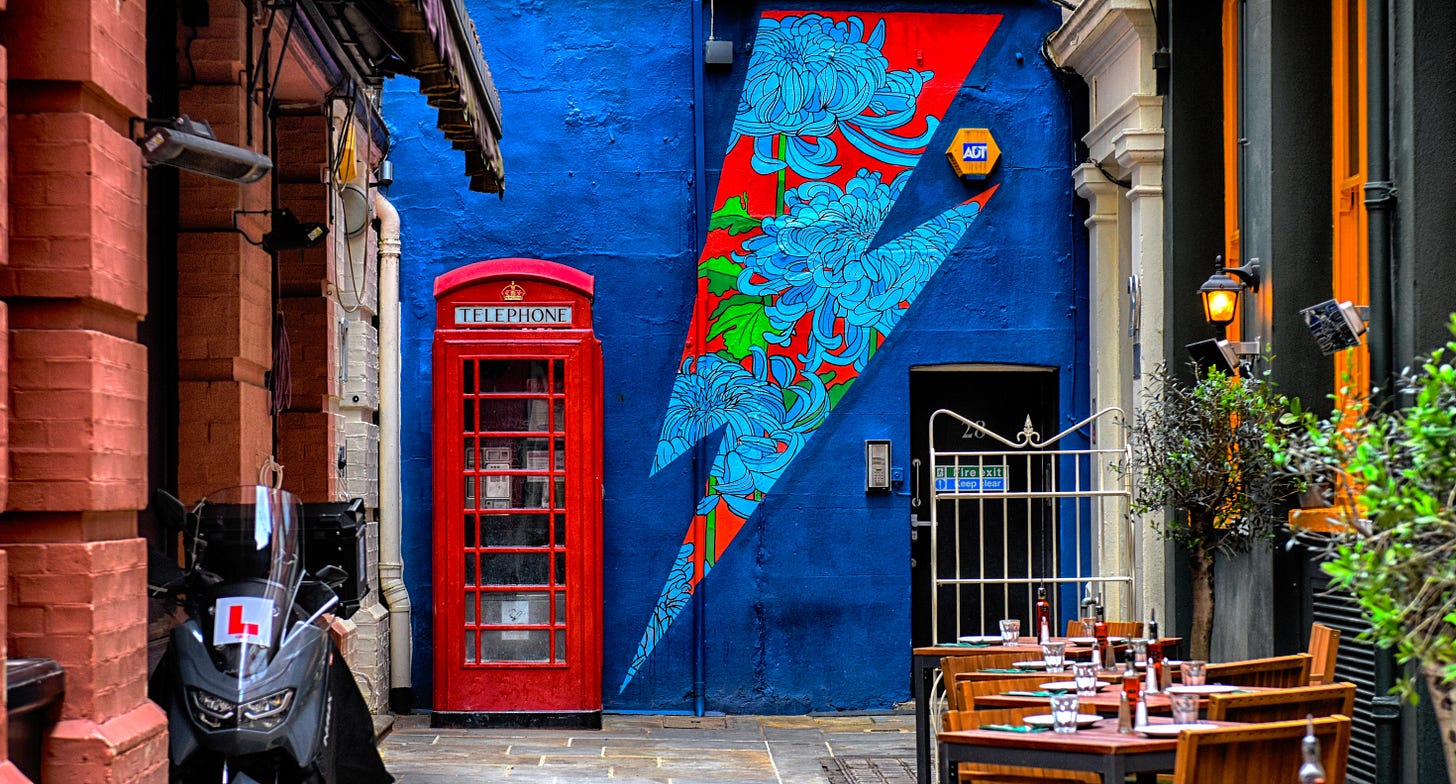
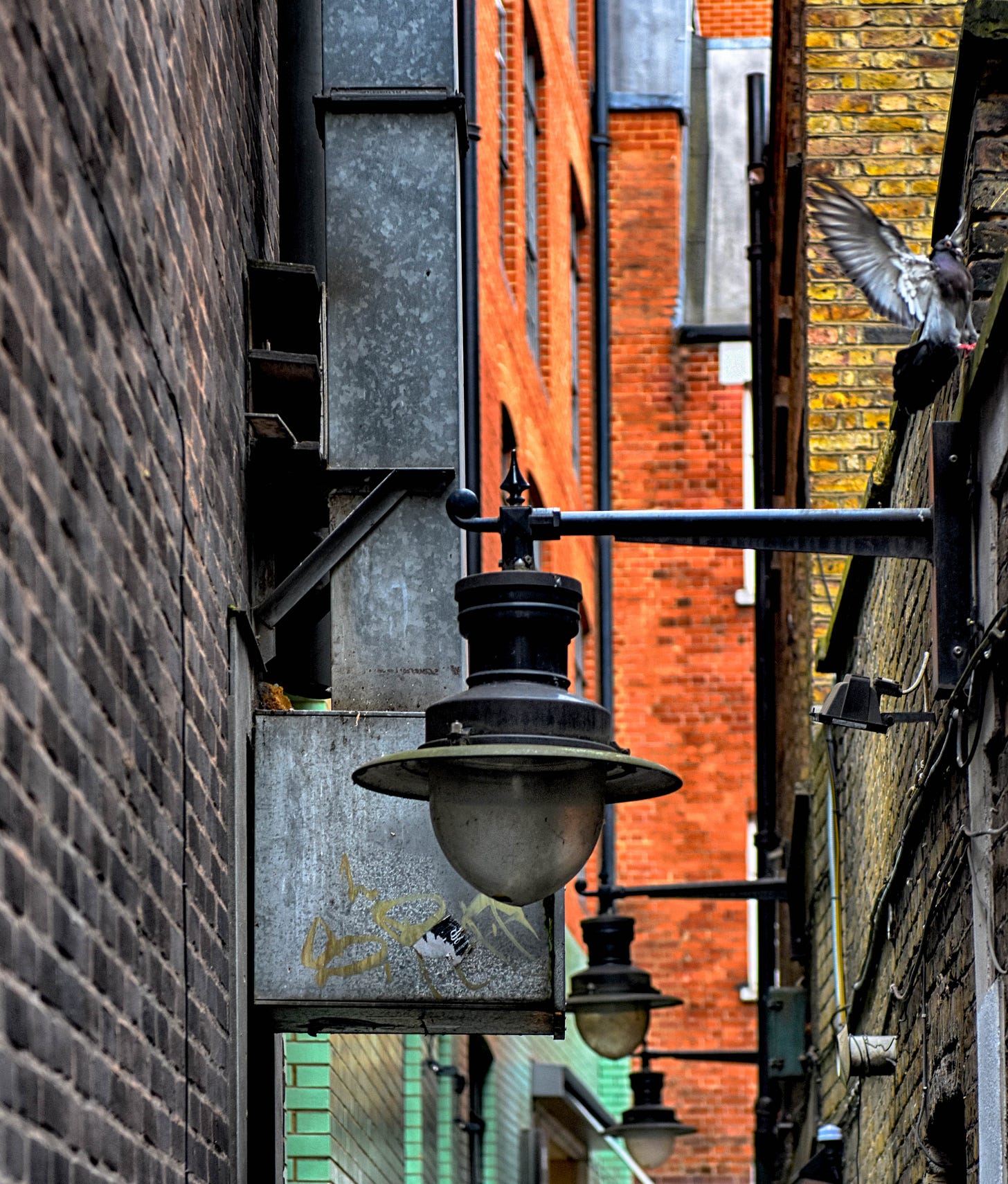
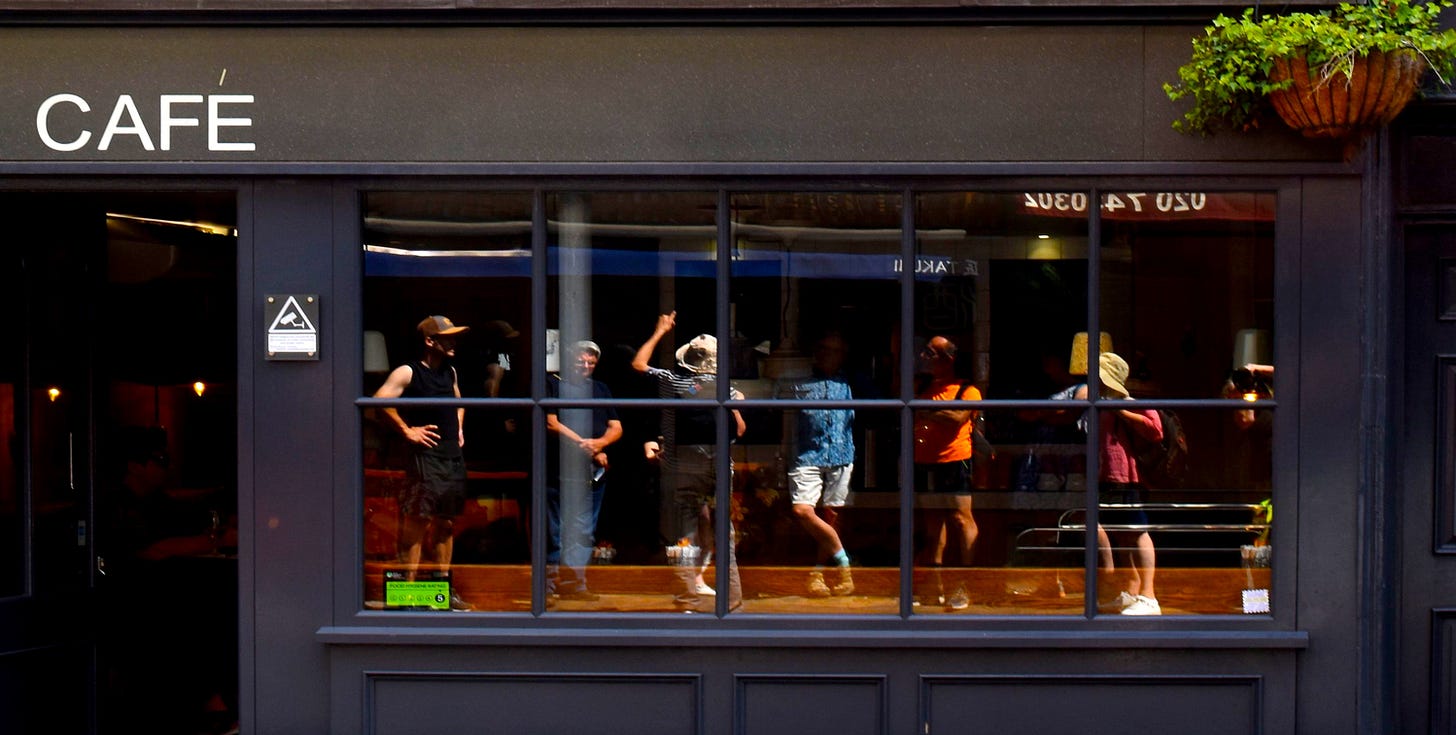
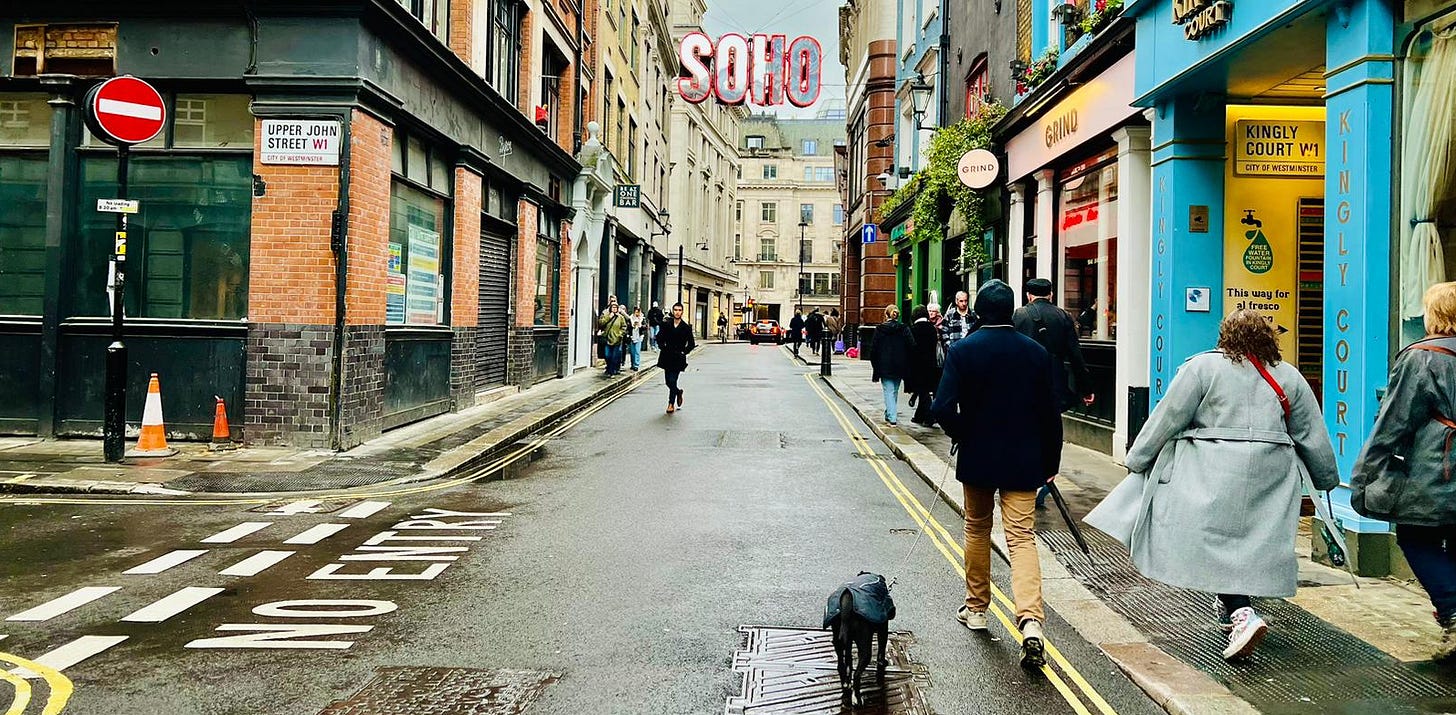
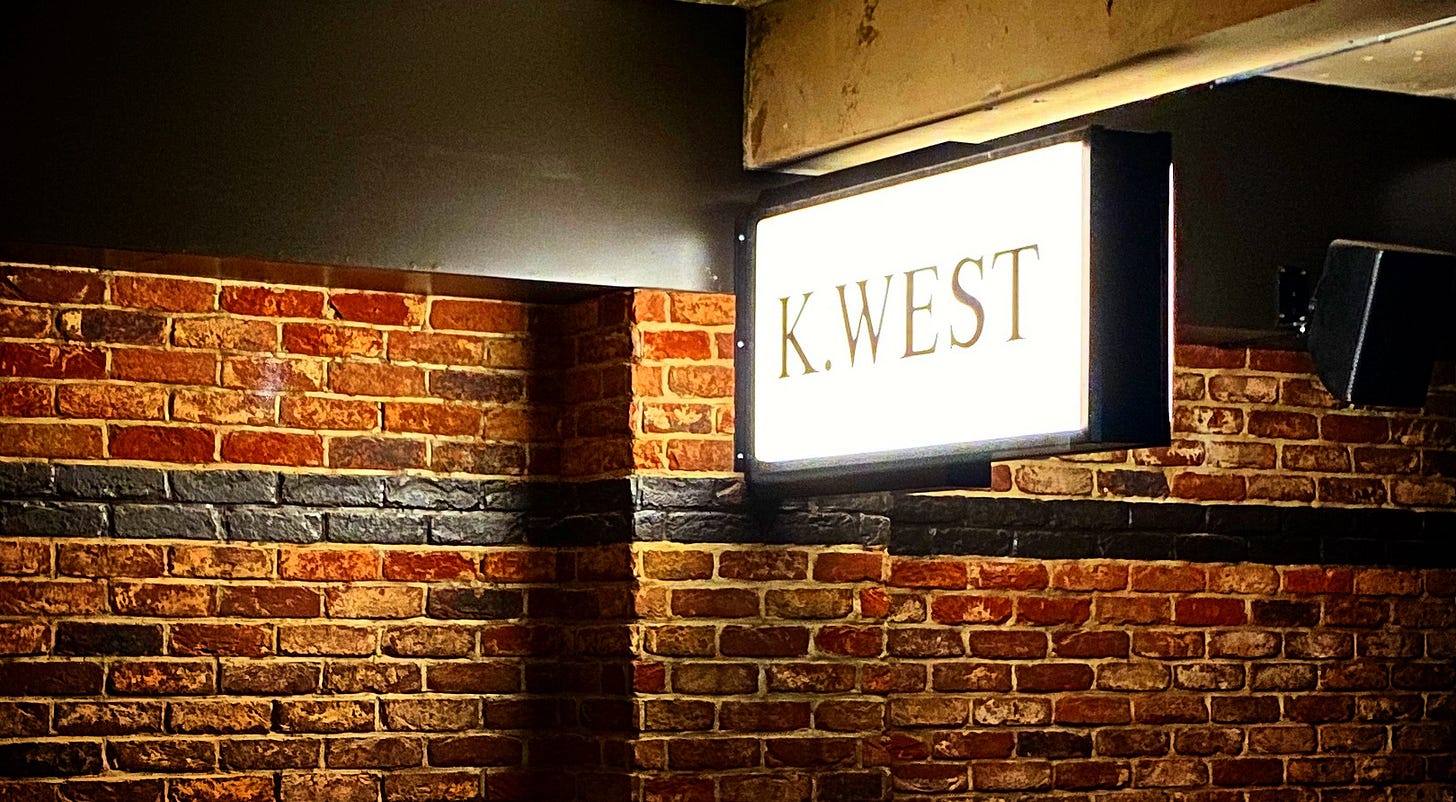
Thank you for this piece. For the readers here, I want to say that I had the privilege of going to 2 of the tours with Jackie and Mike, and it was just awesome! Lots to learn, discover and go on a memory lane! So if you found this article insightful, the live tour is even better, if you're in London!
Another fine piece - stunningly well researched. Glad to see that Mr K Marx gets a mention as a Soho resident- his address at 28 Dean Street is now the site of the historic Quo Vadis restaurant. It was also the site of a well known Brothel back then. At least the good folk plying their trade there would have recognised his concept of Surplus Labour !!
Ray Massey